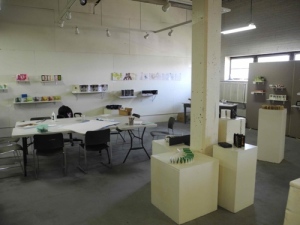by Keeney Swearer
Entering the Fourth Annual Illustrated Accordion exhibition at the Kalamazoo Book Arts Center located in Suite 103A of Park Trades Center, you see a wide variety of ways in which artists are approaching accordion bookmaking. This show is based on submissions from as far away as Great Britain. Entry into this non-juried show only required a fee and “All media, variations, and interpretations of this style of book will be accepted and included in the exhibition.” [1] The show opened during the May 4th Art Hop and ran until May 25th. This show presented the ways in which accordion books are influenced by both two-dimensional graphic techniques and the fact that they are also sculpture.

Installation view of 4th Annual Illustrated Accordion, Kalamazoo Book Arts Center, Photo by Keeney Swearer
An accordion book is created by folding paper back and forth instead of all the sheets being stuck to a spine. This creates possibilities for images on both sides and also lets the book be set upright and expanded. Accordion books, as objects that take up three-dimensional space but are also created of paper, connect with both sculpture and graphic arts. Although the books themselves contain graphic art, they are constructed into forms that are three-dimensional. Sculptures, as defined in Art Fundamentals, are three-dimensional objects that have form, mass and volume. [2] Books take the single plane of paper and turn it into many planes that enter into space, creating forms that interact with space.
The accordion books in this exhibit vary from emphasizing paper and graphic techniques to sculpture, depending on the artist. For example Amy Pirkle’s Gravity’s Light Grip (2007), uses space effectively, allowing the viewer to see different aspects of the work depending on which side the viewer approaches it from. Standing on one side you see frames that line up to reveal hands tying a tie; on the other side you see a poem. The artist controls the way that the viewer interacts with the work and which way they can approach it by the position of the book. The artist blends graphic arts and sculpture to create a hybrid. The images on the pages are seen by the viewer, but the sculptural nature of the book is what controls the way the viewer sees the images.
Some books in the exhibition emphasize more sculptural aspects. For example, Taylor Adams’s Thanatophobia is more sculptural since the imagery on the pages is present only to add color to the sculptural aspects of the book rather than to present specific images on paper. Thanatophobia is based on the folded squares of the accordion books but from the pages that might have text on them instead spring cut pieces of paper. These pieces of paper are cut into triangles and seem to come from every direction. The pieces of paper seem to take up so much space the book would be unable to close, but beside it in the exhibit is the case that it is stored in, assuring the viewer that this book does in fact close. Although still a book, the work is seen more as sculpture than graphic arts placed onto pages. Unlike Gravity’s Light Grip, Adams does not attempt to balance sculpture and graphic arts, instead she focuses on the possibilities sculpture allows with cut paper folded and glued in such a way that it forms a book. We can contrast Adams’s piece with Susan Viguer’s Tiptoe through the Cosmos. This piece is constructed very simply and is designed to emphasize the paper’s surface. The sculptural aspects of the book recede and instead attention is drawn to the graphic arts that have been placed on the pages. The book is displayed completely unfolded, unlike others that stand on their own, and the images printed on the surface come forward.
The Kalamazoo Book Arts Center’s accordion book show successfully demonstrated the different ways in which accordion books connect the sculptural and two dimensional paper arts. Accordion books, more than other books express this combination. Gravity’s Light Grip is essentially a hybrid, relying on both sculptural and paper book references. Other pieces seem to emphasize either the sculptural aspects of accordion books or the paper graphic aspects. Just as contemporary artists of today are using multimedia techniques that bridge the line between sculpture and graphic arts by using encaustics on sculpture, or using fiber arts to create sculptural forms, artists in this show are using accordion books to show us the way artwork does not have to be either two-dimensional or three. [3] Pieces like Gravity’s Light Grip are a dynamic synthesis of the two. Artists in this show are using accordion books to show us the way in which what we see as two very different areas, graphic arts and sculpture, are actually very easily bridged in the book arts. Accordion books also illustrate to us that the preconceptions we hold about the differences in art media are not nearly as different as we would believe. Clearly there can be much more to books than just what is on the pages or how the book is constructed. What is truly fascinating is the way in which the pages and the construction combine to meet the viewer through their two-dimensional images and their interaction in space.
Notes:
[1] Jeff Abshear to KBAC Mailing List, “The Illustrated Accordion” Call for Entries, email, March 8, 2012.
[2] Otto Ocvirk, Bone Robert, Stinson Robert, and Wigg Philip, Art Fundamentals (Dubuque: Wm. C. Brown Company, 1968), 117.
[3] Cameron Anne Mason, “Taking 2-D to 3-D with Mixed Media,” Fiberarts (2011): 26-27.

